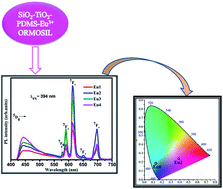Eu3+ doped silica–titania–polydimethylsiloxane hybrid ORMOSILs were synthesized via a non-hydrolytic sol–gel route. The structural and thermal analyses of the samples confirmed that the matrix structure remains unaffected by doping with different concentrations of Eu3+ ions. Photoluminescence (PL) studies performed at 394 nm on Eu3+ doped ORMOSILs imply that they emit broad blue host emission and the characteristic Eu3+ red emissions simultaneously. Also, the samples were excited at the charge transfer (CT) band and this confirmed the existence of an energy transfer path from the host to the Eu3+ ions via Ti4+–O2−–Eu3+ bonds. The phonon energy of the host matrix was estimated by phonon sideband (PSB) analysis and the results were substantiated by Raman analysis. Judd–Ofelt (JO) parameters were also evaluated which give details about the local surroundings of the Eu3+ ions in the system and these parameters were further used for predicting the radiative properties of 5D0 → 7F1,2,4 transitions of Eu3+ ions. Furthermore, the quantum efficiency and CIE co-ordinates were evaluated and it was found that Eu3+ doped silica–titania–polydimethylsiloxane ORMOSIL has an intense pinkish red emission with a quantum efficiency of 30.7%.

